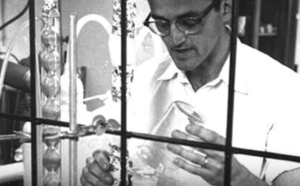Clair Cameron Patterson: An Ardent Campaigner for Cleaner Air

Clair Cameron Patterson was the geophysicist who, in 1953, managed to calculate the age of the Earth. Beyond this enormous achievement, he was also one of the pioneers in the fight against the use of toxic materials in fuels due to their effect on air pollution and, of course, on people’s health.
His fight for clean air for all began in 1965, a time when environmental issues were nowhere near as relevant as they are today. However, Clair Cameron Patterson knew that some industrial practices were threatening the planet and its people, so he decided not to remain silent.
“I would get up and explain how things really work. That was my job.”
-Clair Cameron Patterson-
Thanks to the efforts of Clair Cameron Patterson, in 1970, a law known as the Clean Air Act was passed in the United States. Also, thanks to him, numerous ecologists started to understand the high polluting power of lead in fuels and managed to support these claims in many countries throughout the world.

The life of Clair Cameron Patterson
Clair Cameron Patterson was born in the town of Mitchellville, Iowa (United States), on June 2, 1922. His father was of Scottish origin and worked as a postal administration official. Nevertheless, despite his humble origins, he had a great appreciation for science and instilled that inclination in his son.
Clair’s mother also highly valued the power of education. In fact, she gave Clair a chemistry set that seemed to have planted the seed of his scientific interest. However, he studied in small schools and wasn’t particularly academically outstanding.
Clair received a bachelor’s degree in chemistry from Grinnell College, and later, a master’s degree in molecular spectroscopy. Around the same time, he married his college sweetheart, Laurie. Both he and his wife were invited to work on the Manhattan Project (atomic bomb) at the University of Chicago.
A successful career
After World War II, Clair and Laurie decided to continue their education. Clair did a doctorate and was hired by the California Institute of Technology in 1952. While there, he became one of the founders of the geochemistry department and worked there until the end of his life.
Clair Cameron Patterson, along with his colleague, George Tilton, developed a method for calculating geologic times based on uranium and lead. In this way, he managed to establish the probable age of the planet, which he determined to be 4,550 million years. This is considered the most important dating that exists to date and has remained unchanged since 1956.
Another of Patterson’s great contributions was discovering that there were significant levels of lead contamination on the earth’s surface. This discovery led him to wonder about the effects of such pollution on the atmosphere and on the human body. In fact, he started a fight to avoid this phenomenon.

A historic fight
Patterson discovered that lead reached everyday compounds such as gasoline and food cans, through a compound called tetraethyl lead. He proposed to fight for its prohibition. However, his main opponent was the Ethyl Corporation, the leading company in the production of lead additives.
What followed for Clair Cameron Patterson was a relentless chase. The large multinationals began to use all their power and influence so that he found doors closed to him everywhere. He was even denied a research contract with the United States Public Health Service.
In 1971, he was denied participation on a National Research Council panel on lead contamination in the atmosphere, even though there was no one in the world who knew as much about the subject.
Nevertheless, in 1978, he was invited to be part of that panel. Furthermore, he was allowed to prepare a document that included the measures to be taken to avoid lead contamination.
Clair’s relentless fight led to an 80 percent reduction in the level of lead in the blood of Americans by the end of the century. He died on December 5, 1995, and, until that day, he never rested in his efforts to obtain cleaner air in the world.
Clair Cameron Patterson was the geophysicist who, in 1953, managed to calculate the age of the Earth. Beyond this enormous achievement, he was also one of the pioneers in the fight against the use of toxic materials in fuels due to their effect on air pollution and, of course, on people’s health.
His fight for clean air for all began in 1965, a time when environmental issues were nowhere near as relevant as they are today. However, Clair Cameron Patterson knew that some industrial practices were threatening the planet and its people, so he decided not to remain silent.
“I would get up and explain how things really work. That was my job.”
-Clair Cameron Patterson-
Thanks to the efforts of Clair Cameron Patterson, in 1970, a law known as the Clean Air Act was passed in the United States. Also, thanks to him, numerous ecologists started to understand the high polluting power of lead in fuels and managed to support these claims in many countries throughout the world.

The life of Clair Cameron Patterson
Clair Cameron Patterson was born in the town of Mitchellville, Iowa (United States), on June 2, 1922. His father was of Scottish origin and worked as a postal administration official. Nevertheless, despite his humble origins, he had a great appreciation for science and instilled that inclination in his son.
Clair’s mother also highly valued the power of education. In fact, she gave Clair a chemistry set that seemed to have planted the seed of his scientific interest. However, he studied in small schools and wasn’t particularly academically outstanding.
Clair received a bachelor’s degree in chemistry from Grinnell College, and later, a master’s degree in molecular spectroscopy. Around the same time, he married his college sweetheart, Laurie. Both he and his wife were invited to work on the Manhattan Project (atomic bomb) at the University of Chicago.
A successful career
After World War II, Clair and Laurie decided to continue their education. Clair did a doctorate and was hired by the California Institute of Technology in 1952. While there, he became one of the founders of the geochemistry department and worked there until the end of his life.
Clair Cameron Patterson, along with his colleague, George Tilton, developed a method for calculating geologic times based on uranium and lead. In this way, he managed to establish the probable age of the planet, which he determined to be 4,550 million years. This is considered the most important dating that exists to date and has remained unchanged since 1956.
Another of Patterson’s great contributions was discovering that there were significant levels of lead contamination on the earth’s surface. This discovery led him to wonder about the effects of such pollution on the atmosphere and on the human body. In fact, he started a fight to avoid this phenomenon.

A historic fight
Patterson discovered that lead reached everyday compounds such as gasoline and food cans, through a compound called tetraethyl lead. He proposed to fight for its prohibition. However, his main opponent was the Ethyl Corporation, the leading company in the production of lead additives.
What followed for Clair Cameron Patterson was a relentless chase. The large multinationals began to use all their power and influence so that he found doors closed to him everywhere. He was even denied a research contract with the United States Public Health Service.
In 1971, he was denied participation on a National Research Council panel on lead contamination in the atmosphere, even though there was no one in the world who knew as much about the subject.
Nevertheless, in 1978, he was invited to be part of that panel. Furthermore, he was allowed to prepare a document that included the measures to be taken to avoid lead contamination.
Clair’s relentless fight led to an 80 percent reduction in the level of lead in the blood of Americans by the end of the century. He died on December 5, 1995, and, until that day, he never rested in his efforts to obtain cleaner air in the world.
All cited sources were thoroughly reviewed by our team to ensure their quality, reliability, currency, and validity. The bibliography of this article was considered reliable and of academic or scientific accuracy.
Trigo Rodríguez, J. M. (2012). Las raíces cósmicas de la vida (Vol. 5). Servei de Publicacions de la Universitat Autònoma de Barcelona.
This text is provided for informational purposes only and does not replace consultation with a professional. If in doubt, consult your specialist.







